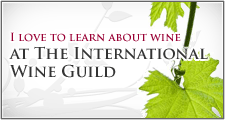#1 Sniffing the Cork:
Ah the beauty of ritual. Rituals are wonderful because they help us define our culture. They can add color, meaning and a sense of purpose to our lives. But there is also the possibility of reading too much into rituals without understanding their historical basis or viability. Sniffing the cork is one such ritual – a ritual that at its heart speaks to the importance of enjoying every second of the wine drinking experience, popping the cork not withstanding. To sniff the cork is a way to bring this moment home – to bring yourself to the present and get ready for the adventure and excitement that (hopefully) awaits in the bottle you are about to drink.
However, sniffing the cork has very little to do with being able to determine the quality of the wine. This is especially true for anyone who is not the most highly trained and gifted oenologist on the planet - and even in this case it would be questionable as to whether the individual would, in fact, be able to detect the presence of mold on the cork which could help diagnose a bad bottle.
So if you find yourself in the company of anyone who is not one of the most highly trained and gifted oenologists on the planet, be wary of the person who sniffs the cork. It’s a simple ritual at best and pretentious and unnecessarily intimidating at worst.
#2 Red Wine with Meat and White Wine with Fish
Rules seem to make difficult tasks easier. Whether it’s two national football teams clashing on the field to try and claim victory without physically killing each other, or learning what wine best compliments a certain food, rules make things possible. However, in the latter case rules make things so much more boring - particularly in this day and age when there are more bright and complex whites and more soft and delicate reds than ever. You simply cannot make such a generalization without killing the fun of experimentation and the sense of irreproducible pleasure that comes from a truly synergistic wine and food match.
One of the biggest victims of wine and food pairing generalizations is Champagne. A wine that is best known as a “celebratory” wine in the states, Champagne, in fact makes an excellent companion to finger foods like fish and chips! The best rule of thumb with wine and food matching is to feel free to explore and experiment. When it’s all said and done, most wines go with most foods - it’s just a match made in heaven. Sorting out the details can be fun, but certainly don’t make it stressful!
#3 Letting Wine Breath in the Bottle
Individuals who pop open a bottle and insist on letting it sit for a certain period of time before drinking it may or may not be the same ones who will sniff the cork. Letting the wine breathe is another fine wine ritual, and a ritual that is actually grounded in some fact. It is true that allowing some time for red wine to be exposed to the air will help open up its flavors and aromas. However, this is best done in the glass or in a decanter, not the bottle.
The reason is that the surface-to-air exposure in the space within the neck of the bottle is so small, very little oxygenation actually occurs. It’s like saying a traveler who has been stuck on a five-hour plane ride will feel less cramped and more stretched-out simply because the stewardess pops the door open when the plane lands. Most would agree that the real opening up after a flight occurs when you step off the airplane. It is the same with wine! Get that stuff out of the bottle and let its flavors and aromas be activated by the air in the room. There’s no better place than the glass to make this happen.
#4 Swirling Wine is Unnecessary and Pretentious
Some people would like to think this is true, particularly because wine fans tend to perform glass swirling habits - swirling whatever they happen to be drinking at the time including iced-tea and coffee. It’s important that people feel comfortable swirling and sniffing their wine. Incontrovertibly, putting the wine into action with a few simple swirls helps expand on the effect of letting it breathe in your wine glass. As you swirl, the wine is aerated and the aromas really move upward into the nose and senses. Not only is it fun, but it’s a great way to take in every part of the glass you are about to taste!
#5 Germany is Only Good for Sweet Wine
We can blame this myth on several overlapping phenomena, not the least of which is that it’s pretty difficult for those not fluent in German to understand the complexities of a German wine label. The country’s labels are notoriously detailed, discussing the village name, the vineyard name, the type of grape and an official designation for ripeness. And even understanding all of this, you have to put it in the context of the wine’s alcohol content to understand what style it’s really getting at.
The reality is that Riesling, which has an incredible reputation for sweetness outside of Germany, is one of the most brilliantly complex wines in the world. There are German Rieslings that are drier than a New Zealand Sauvignon Blanc and carry the complexities of a well-aged Bordeaux. Riesling, in fact, is one of the major white wines that ages particularly well. To make sure you’re getting a drier Riesling, look for the alcohol by volume content to be under 12% and stay away from anything that advertises late-harvest. Alsace, just a hop and skip away from some of Germany’s major growing regions, makes some fabulously complex dry Rieslings. When in doubt, ask your sommelier or wine merchant for direction.






